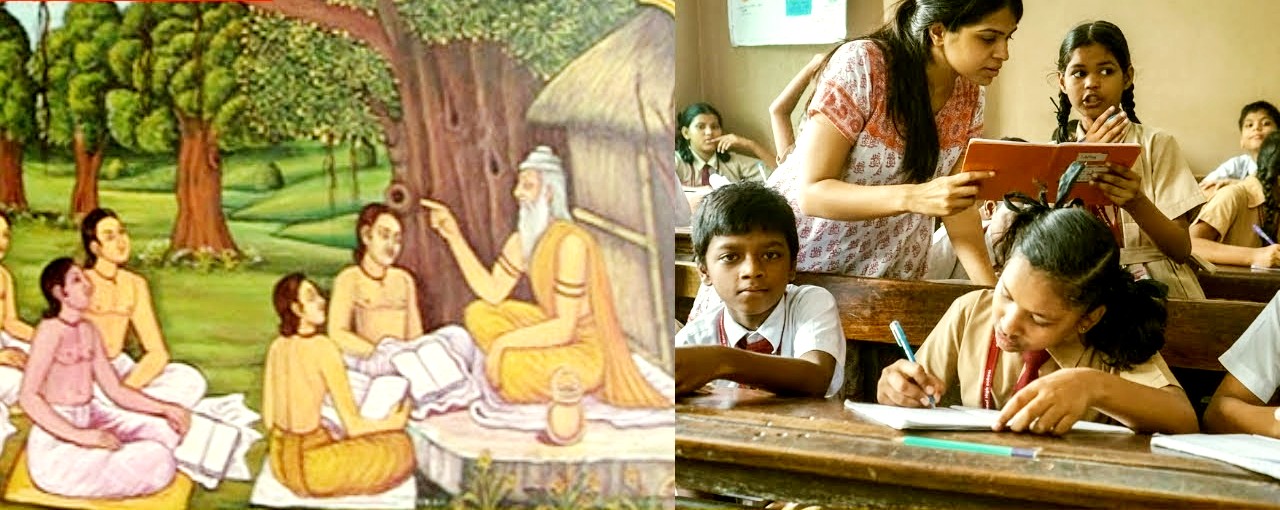From Gurukuls to Global Learning: India’s Educational Journey
From Gurukuls to Global Learning: India’s Educational Journey.

Image Source: teachershelpinghand.com
From Gurukuls to Global Learning: India’s Educational Journey.
The history of education in India is a captivating narrative that unfolds across epochs, weaving together diverse cultural, religious, and socio-economic influences. Spanning thousands of years, the educational journey of India reflects the resilience and adaptability of a society committed to knowledge and intellectual exploration. In this exploration, we will delve into the key periods that have shaped the educational landscape of India, from ancient Gurukuls to the digital classrooms of the present day.
Ancient Period (Before 1000 BCE – 1200 CE):
The roots of education in India run deep into antiquity. The ancient period witnessed the emergence of the Gurukul system, a unique and profound model of education. Originating before 1000 BCE, this system was characterized by an intimate teacher-student relationship. Students, known as Shishyas, lived with their Gurus in hermitages or ashrams. The Gurukuls were not mere institutions; they were centers of holistic learning, imparting not only academic subjects but also philosophy, literature, music, and various facets of life.
The Gurukul system thrived on oral traditions, and the knowledge imparted through the guru-disciple relationship laid the foundation for some of the most revered texts in Indian philosophy, including the Vedas and Upanishads. This period fostered a profound connection between teachers and students, emphasizing not only the acquisition of knowledge but also the holistic development of individuals.
Medieval Period (1200 CE – 1700 CE):
The medieval period brought a confluence of diverse educational influences to India. With the advent of Islamic rule, Islamic education gained prominence alongside the existing Sanskrit-based learning. Madrasas, institutions for Islamic learning, and Maktab schools, providing elementary education, became widespread.
Madrasas focused on religious education, teaching subjects such as theology, law, and Arabic literature. Despite the Islamic influence, traditional Sanskrit education continued to thrive, with scholars making significant contributions to fields such as mathematics, astronomy, and medicine. This period showcased the coexistence and interaction of different educational traditions, contributing to the rich tapestry of Indian learning.
Colonial Period (1700 CE – 1947):
The colonial era marked a significant transformation in India’s education system due to British influence. The East India Company and later the British Crown sought not only political and economic control but also intellectual dominance. The Wood’s Dispatch of 1854 was a turning point, laying the foundation for a modern education system.
The Wood’s Dispatch recommended the establishment of universities, a uniform curriculum, and the use of English as the medium of instruction. The University of Calcutta, established in 1857, was among the first fruits of this new educational approach. While English education contributed to the spread of formal education, it also led to a detachment between the education imparted and the socio-cultural context of India.
The colonial period witnessed a clash of educational philosophies, as traditional Indian knowledge systems confronted the imposition of a Western-style education. The resulting syncretism and adaptation shaped the intellectual landscape of colonial India.
Post-Independence Period (1947 Onwards):
Post-independence, India undertook substantial reforms to redefine its education system with a focus on accessibility and inclusivity. Several key milestones shaped the trajectory of education in the country:
- Sarva Shiksha Abhiyan (2001): Launched to achieve universal elementary education, Sarva Shiksha Abhiyan aimed to bring every child into the fold of formal education.
- National Policy on Education (1968, Revised in 1986 and 1992): These policies aimed to promote education for all and emphasized the importance of science and technology. They outlined strategies for achieving educational goals at various levels.
- Right to Education Act (2009): Enacted to provide free and compulsory education to children aged 6 to 14, the Right to Education Act was a significant step toward ensuring access to education for all.
The post-independence period witnessed a concerted effort to bridge educational disparities and extend the reach of education to marginalized sections of society. The emphasis on universalization of education became a cornerstone of national educational policies.
Recent Years (2010 Onwards):
In the last decade, India’s education system has witnessed a confluence of traditional wisdom and modern advancements:
- Digital Initiatives: The rise of digital learning platforms, e-books, and online education has brought about a paradigm shift in how education is accessed and delivered. E-learning has become particularly prominent, especially in the wake of global events that necessitated a shift toward remote learning.
- National Education Policy (NEP) 2020: The National Education Policy of 2020 marked a comprehensive effort to revamp the education system. It aimed at providing a more holistic and flexible approach to learning, encouraging multilingualism, and promoting a shift towards competency-based education.
The NEP 2020 addresses various aspects of education, including early childhood care and education, school education, higher education, and vocational education. The policy stressed the importance of critical thinking, creativity, and a more learner-centric approach.
The recent years have witnessed a dynamic interplay between traditional modes of education and innovative approaches enabled by technology. The digital revolution has not only expanded access to education but has also redefined the modes of teaching and learning.
Conclusion:
The history of education in India is a dynamic narrative that spans millennia, reflecting the country’s commitment to knowledge and intellectual exploration. From the Gurukuls of ancient times to the digital classrooms of today, the journey has been marked by resilience, adaptability, and a quest for excellence.
As India strides into the future, the challenges and opportunities in education are vast. The integration of technology, the reimagining of pedagogy, and the emphasis on holistic education mark a dynamic and evolving landscape. The history of education in India is not merely a record of the past but a living testament to the transformative power of knowledge and the continuous quest for enlightenment. It is a story that continues to unfold, with each chapter adding new dimensions to the educational odyssey of this ancient land.
From Gurukuls to Global Learning: India’s Educational Journey.
Author: Harendra Kukna

Leave a comment